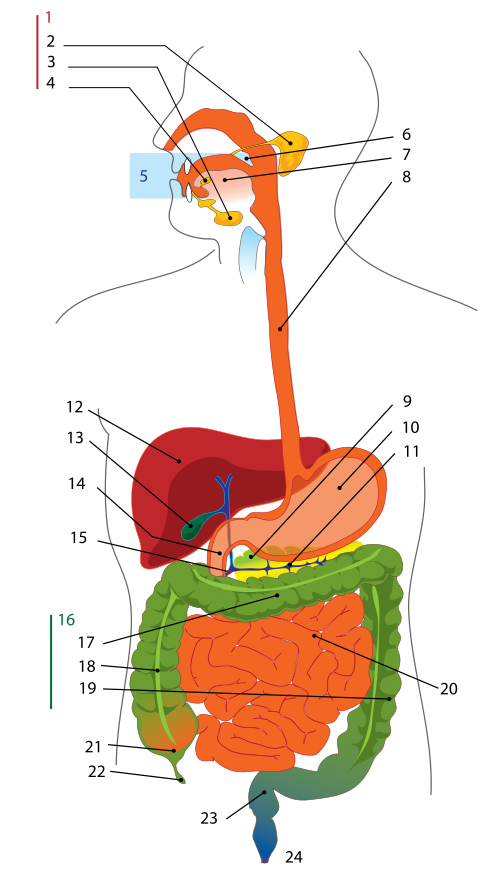
Biology
Chapter 21: 1-13

Lecture
The Digestive System
Web Lecture
Components of Digestive Systems
You may want to review the development of tissue types in the gastrula of animals that lack a coelom, animals with a pseudocoelom, and animals with a true coelom. The development of the coelom will determine the complexity of the digestive tract. In fact, as we go through the different systems with emphasis on human anatomy and physiology, you may find it useful to compare these "complex" systems with their counterparts in other animals by refer to the chart in the weblecture on invertebrates.Simple Digestive Systems
Simple digestive systems have a single opening, through which food enters and wastes leave. Primary digestion occurs when cells lining this cavity release enzymes into the cavity to break down food; digestion continues in food vacuoles within cells, and the resultant nutrients diffuse into other cells. Undigested food is forced out through the mouth opening.
Complex Digestive Systems
As we have already seen, during empbryonic development in more complex animals, the developing gastrula structure folds up and forms three rings:
- the outer endoderm becomes the skin layer
- the inner mesoderm forms cavities holding the various organs
- the central ring or endoderm becomes the lining of the gut
In most vertebrates, food undergoes different digestive processes; starches, proteins and fats are broken down by specialized enzymes secreted by different organs at different points along the way. In the human, food is digested as follows:
| Mouth → | Ingestion (plus some digestion) Teeth grind food into smaller particles Saliva glands secrete amylases to break down starches Swallowing passes food to |
Hydrolysis! Enzymes include: sucrase (breaks bonds between dissachyride monomers) |
| Pharynx → epiglottis → esophagus → | Ingestion Bolus traveling; no digestive activity |
No enzyme activity |
| Stomach → | Digestion Glands in stomach lining secrete hydrochloric acid to produce pepsin to break down proteins. Note that these also break down salivary amylase so that starch digestion slows to a halt in the stomach. The stomach pushes food out the pylorus. |
Hydrolysis! Enzymes include: pepsin (breaks peptide bonds in amino acids of proteins) |
| (Small intestine)
Duodenum → jejunum → ileum → |
Absorption Food in the duodenum is broken down chemically by bile from the liver and enzymes from the pancreas, as well as enzymes from the walls of the intestine. The base nutrients are absorbed through the cells lining the villi, projections which increase the surface area of the small intestine to the size of a tennis court. |
Hydrolysis! Enzymes include: bile salts produced by the liver and gall bladder to break down fatty acids and nucleic acids |
| (Large intestine)
cecum → colon → rectum |
Absorption and Elimination The walls of the large intestine absorb water and sodium from any undigested food, and bacteria in the intestine continue the breakdown (and incidentally produce vitamins for their host organism). These wastes are then eliminated from the body. |
Limited enzyme activity. |
| Liver | Filtration Blood from the intestinal lining is filtered to eliminate contaminants. |
Limited enzyme activity. |
The Human Digestive Systems
The main components of the human digestive system are listed in the table above. Trace the passage of food through the diagram below, and try to identify each numbered organ. When you hover over the diagram, you'll be able to see the actual names. Use the diagram to drill yourself, and be sure to identify the function of each organ as well.
Test yourself
Check The Innerbody for animations and more details on aspects of the digestive system that interest you.
© 2005 - 2024 This course is offered through Scholars Online, a non-profit organization supporting classical Christian education through online courses. Permission to copy course content (lessons and labs) for personal study is granted to students currently or formerly enrolled in the course through Scholars Online. Reproduction for any other purpose, without the express written consent of the author, is prohibited.
